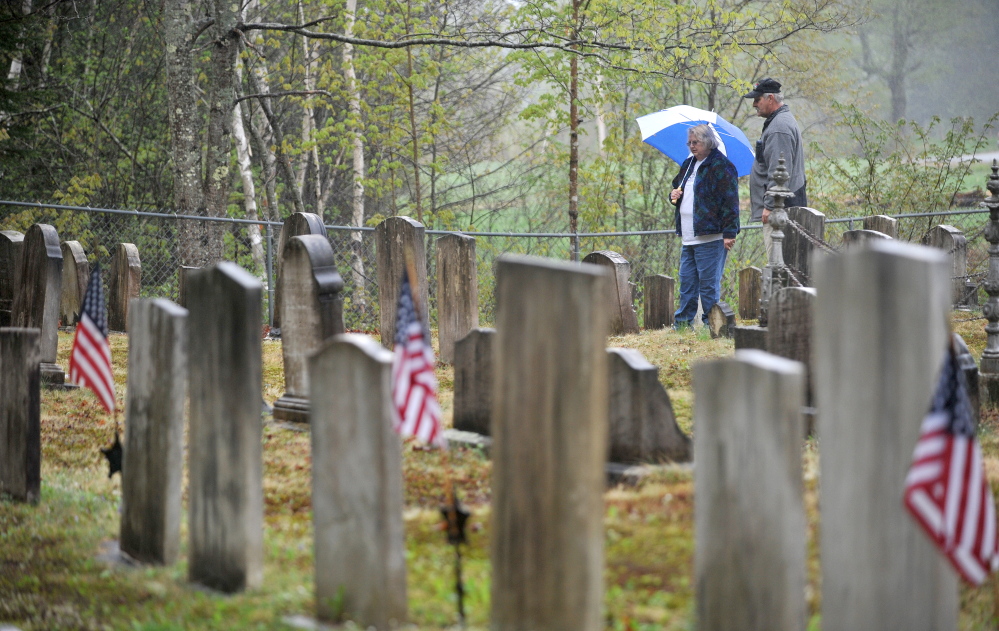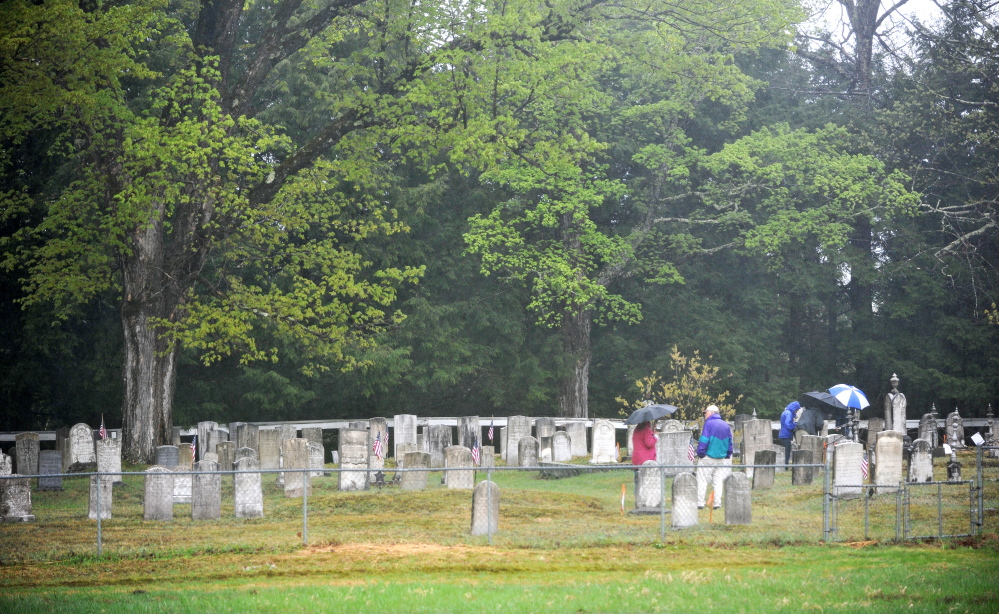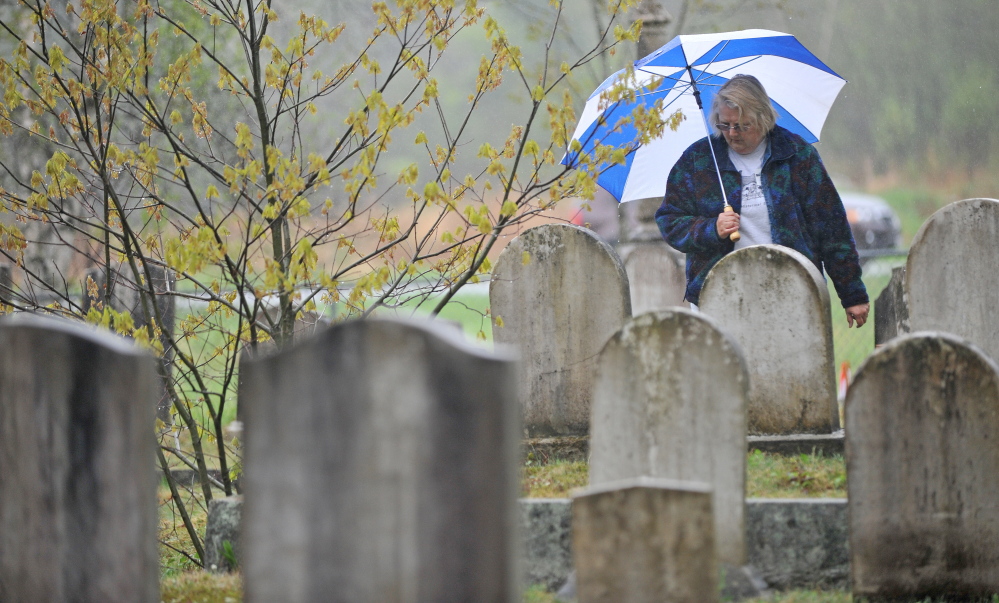STARKS — From the intersection of State Route 134 and Sandy River Road, travel about a half mile toward New Sharon, and walk into the woods on the left.
Walk through a pine grove on a former woods road.
When the path divides, bear left for about 300 feet, down a hill and across a ravine.
These are the directions to the cemetery near Witham Corner, one of about 20 cemeteries in the town of Starks, marked only by four posts surrounding the small yard of six headstones. Visitors to Witham Corner and the other cemeteries in town of about 600 people are rare, but on Friday cars lined the roads outside and several visitors tramped through the rain to get a look at the headstones.
“When we pull up, all the locals wonder whose funeral it is,” said Albert Stehle, a member of the Maine Old Cemetery Association. “It’s a different type of person who goes out in the woods and looks for cemeteries.”
The statewide association based in Augusta is dedicated to the preservation of Maine’s cemeteries. Three times a year, its members meet in a different location around the state to promote their work, which is as much about preserving and learning about history as it is about the cemeteries themselves. On Sunday the group will promote the start of Maine Old Cemetery Week, which runs through May 24 and encourages people to get involved in the upkeep of their local cemeteries.
But on Saturday, about 65 people — some from as far away as South Portland, Lincolnville and Bethel — came to Starks, where despite a steady rainfall they visited some of the town’s most historic cemeteries.
“It’s really an open-air museum. You have the artwork, the genealogy and the epitaphs, the history,” said Cheryl Willis Patten, a Smithfield resident and the president of the Maine Old Cemetery Association, also known as MOCA.
There are about 6,000 cemeteries in Maine, all of which can tell us something about the geography and history of the area they are in, Patten told the group on Saturday prior to their departure on the tour.
In Starks, the history of cemeteries is tied closely to the town’s complicated religious past.
The town, which was settled in 1772 and incorporated in 1839, did not have a church until 1839. The first cemetery, Village Cemetery, was built near Sawyer’s mill, which was built by Luke Sawyer, a guide for Benedict Arnold during the Revolutionary War.
It’s not officially known why, but in the 1860s the cemetery was moved, probably because residents were worried about possible water contamination because of the cemetery’s proximity to the town well, according to Paul Frederic, vice president of the Starks Historical Society.
“How much of it still exists is anybody’s guess,” Frederic said. “Historically we’ve had a struggle with religion, and with that, cemeteries — where to put them, and whether they should be moved.”
Today the old cemetery, the burial place of some of the town’s first settlers, is next to a house that recently appeared on the Travel Channel’s show “The Dead Files,” which features what it identifies as haunted sites around the U.S. and calls in a psychic medium and police detective to study paranormal activity.
There are many theories in town about whether the house at the corner of Chicken and Main streets actually is haunted, and its proximity to a former cemetery site plays a role in those theories.
A specialist in cemetery mapping said Saturday that it can be difficult to determine the state of old cemeteries and former cemetery sites.
When a cemetery has been disturbed, there isn’t always physical evidence, said Michael Scully, vice president of Northeast Geographical Surveys in Bangor. Scully specializes in ground penetrating radar, a technology that sends radar energy into the ground and reads reflections off subsurface objects to map what is below. The technology is used in excavation, the laying of pipes and roads and cemetery mapping, as well as other things.
“Excavation disturbs the soil, but I think sometimes over a long period of time the soil will heal itself,” Scully said. “You can’t always tell if a body or a cemetery has been moved.”
The first stop on Saturday’s tour was at Frederic Cemetery, one of three cemeteries where headstones and maybe some remains were moved when the Village Cemetery moved.
Some of the plots had been marked with bright pink ribbons and laminated sheets of paper holding copies of the gravestone design. Scully gave a demonstration of the radar technology, slowly moving the $25,000 machine, which looks similar to a lawnmower, over the plots and picking up signals for where there were caskets below. People crowded around him to get a good look.
They hope that the technology, and the overall study of Maine’s cemeteries, can provide clues to the past — whether it be related to their own genealogy or a larger historical context.
Stehle, who lives in Biddeford and works as a mason, said that his work in old houses got him interested in genealogy and archaeology. “It makes a house more valuable, makes a homeowner more excited, and it all really starts with finding those people from way back,” he said.
Others are drawn to the association to discover their own roots or to see other parts of the state.
Marianne Chapman and her husband, Paul, of South Portland, said they became involved in the association about three years ago while working to resurrect a nearby cemetery where teens would go to drink and party.
Marianne Chapman was fascinated to find out how many of the stones were unmarked.
“It’s a whole piece of history that has been lost, and it’s fun. You get to see towns that you would otherwise never go to,” Chapman said.
Patten, who grew up in Starks, said visiting cemeteries was always a part of her childhood. Her mother was the town clerk and would be tasked with answering people’s letters about family history and genealogy, often by making visits to the local cemeteries.
“There are people who lived who never owned property, so there are no property deeds in their name. But if someone cared about them, they would put a stone beside where they were buried,” she said.
Rachel Ohm — 612-2368rohm@centralmaine.com
Copy the Story LinkSend questions/comments to the editors.






Success. Please wait for the page to reload. If the page does not reload within 5 seconds, please refresh the page.
Enter your email and password to access comments.
Hi, to comment on stories you must . This profile is in addition to your subscription and website login.
Already have a commenting profile? .
Invalid username/password.
Please check your email to confirm and complete your registration.
Only subscribers are eligible to post comments. Please subscribe or login first for digital access. Here’s why.
Use the form below to reset your password. When you've submitted your account email, we will send an email with a reset code.